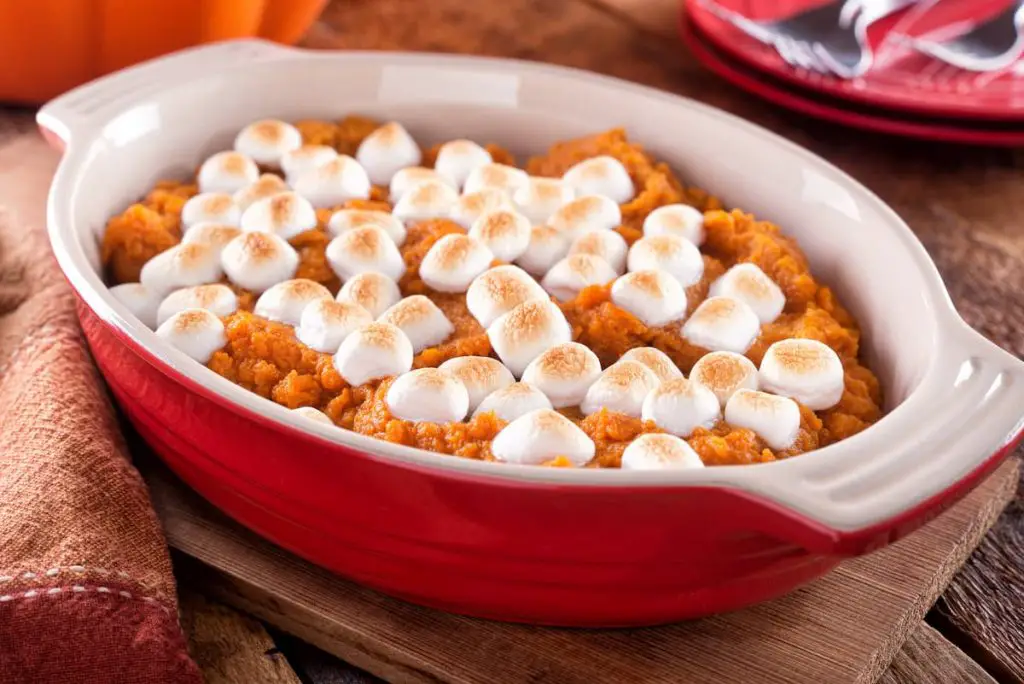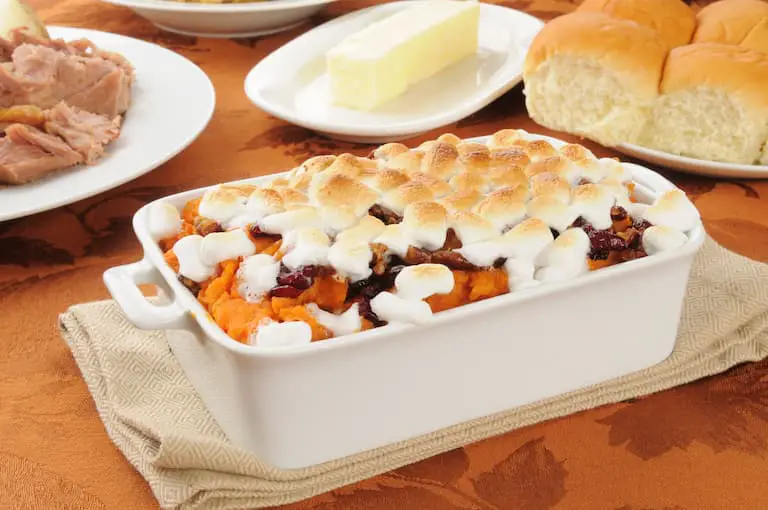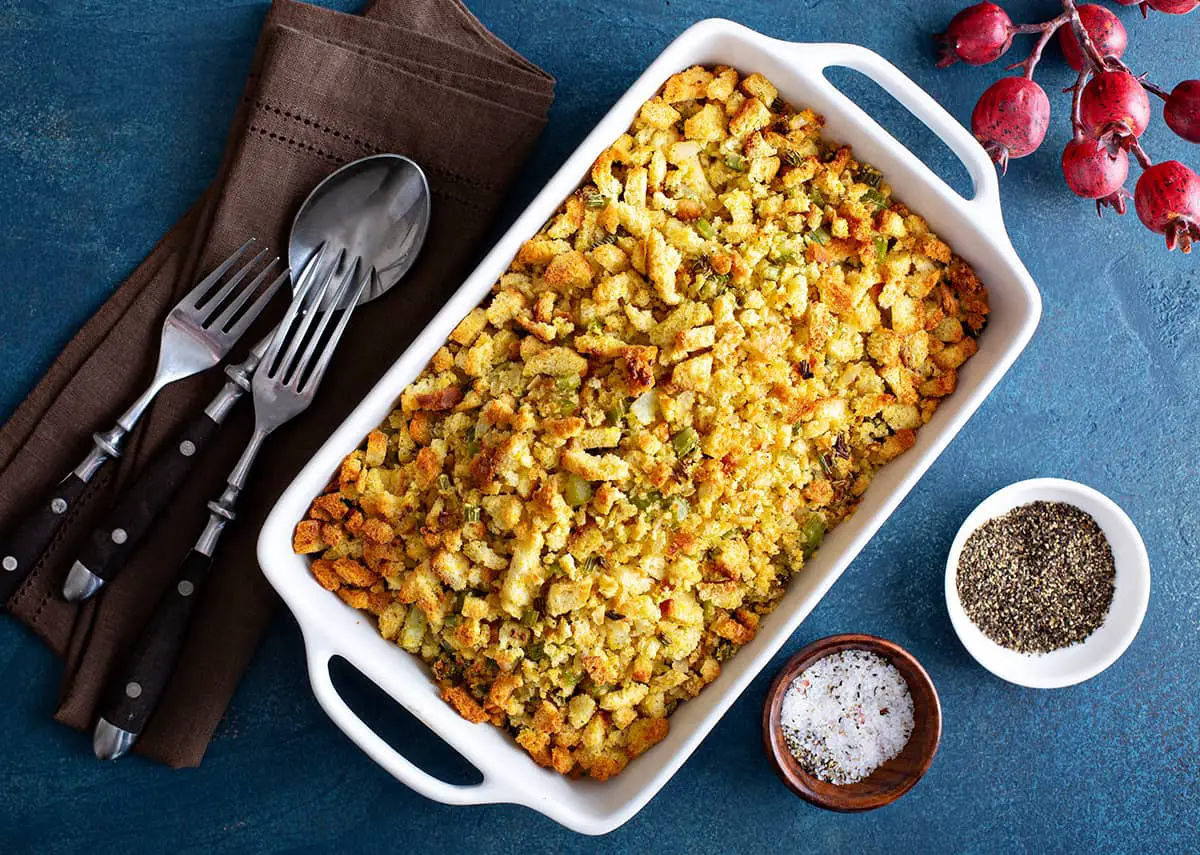Can You Freeze Sweet Potato Casserole? (YES! Here’s How)
Who doesn’t love a good home-cooked sweet potato casserole? Tender-baked sweet potatoes, drowning in butter with just a hint of cinnamon-y sweetness, topped with a crisp marshmallow crust is enough to make anyone’s mouth water. But, can you freeze a sweet potato casserole and save it for later?
Sweet potato casserole can easily be frozen. It’s ideal to allow the casserole time to cool, and then transfer it to a freezer-safe dish before freezing it. However, sweet potato casserole can be frozen in its original baking dish, when it’s wrapped properly.
In this article, I will explain how to prepare your sweet potato casserole for freezing, how to thaw it, and how to warm up your sweet potato casserole properly. I’ll also go over a few twists on the traditional sweet potato casserole recipe (that might just surprise you).

How To Prepare Cooked Sweet Potato Casserole for Freezing
Frozen Sweet Potato Casserole Recipe
For a sweet potato casserole you plan on freezing and eating later; you can use any recipe. Just cook it as you would normally – with one exception. Keep any toppings for the casserole separate.
You can store these in a little plastic baggie for use when you warm the casserole up later, or if you plan on freezing the casserole for an extended period of time, make a note of what those toppings were so you know to add them later.
How To Wrap a Sweet Potato Casserole for Freezing
To wrap a sweet potato casserole for freezing, first, allow it to cool down to room temperature. Then, you can transfer the sweet potato casserole to a freezer-safe container or keep it in its original baking dish.
If you choose to keep the sweet potato casserole in its original baking dish, make sure to wrap it extra tight to keep it fresh in the freezer. One method is to cover the whole casserole dish in plastic wrap, and then wrap a layer of aluminum foil over the plastic wrap. Afterward, you can finish by putting the wrapped dish inside a zip-top bag or another plastic bag.
However, don’t forget to label your casserole with the type of dish and the date you froze it. Most casseroles wrapped in this method will keep up to at least three months in the freezer.
Freezing Leftover Sweet Potato Casserole
Can you freeze leftover sweet potato casseroles even if you didn’t take the time to separate the toppings specifically for freezing? Of course! Just take the same care in wrapping up your leftover pieces to prevent possible freezer burn.

While the toppings might get mushy when you reheat the casserole later, you could always add more toppings when you reheat it. Just be sure to label it and make sure that the wrapping is nice and tight!
Can You Freeze Sweet Potato Casserole Before Baking?
Sweet potato casserole can also be frozen prior to baking it. The most critical factor in preparing your whole uncooked sweet potato casserole for freezing is ensuring that your casserole does not include any raw vegetables as toppings before freezing. Raw vegetables contain a lot of water, and when you freeze them, this causes the cells to burst.
Therefore, when you thaw and cook these frozen, uncooked vegetables later, it results in discolored, mushy veggies that bear little resemblance to the beautiful veggies they were before.
How To Thaw a Frozen Sweet Potato Casserole
While it’s highly recommended that you thaw your frozen casserole before baking it, you can go straight from the freezer to the oven. However, this will add additional baking time to your casserole, and you still risk the middle being less warm than the edges.
Another downside to putting the frozen casserole directly into the oven is that extreme temperature changes can cause ceramic or even glass containers to crack or break.
To avoid having your casserole dish break, it’s best to take some time to plan ahead and defrost your sweet potato casserole before warming it back up.
If you decide to forgo the defrosting process, be sure to add at least 50% more time to your baking process. However, if you have the time for it, consider one of the following methods of defrosting your casserole:
Refrigerator Method
The best method to defrost any frozen dish is to do it slowly in the refrigerator. This method ensures that the food is being thawed evenly with no part of the food getting too warm. Most sweet potato casseroles can be thawed with this method between 24 and 36 hours, depending on the size of the dish.
Cold Water Method
If you are in a bit of a time crunch, you can also try the cold water method. This method involves setting your tightly wrapped casserole into a basin of cold water. Every 30 minutes to an hour, change the cold water until the casserole is thawed. This method can take up to a few hours, depending on the size of the dish you’re trying to thaw.
Microwave Method
This method is the least desirable but can be used if you are in a rush. Using the defrost setting on your microwave, program it to the appropriate number of minutes. Make sure you rotate and check your casserole frequently so it doesn’t burn or bubble over. However, be prepared to have a less-than-average sweet potato casserole when using this method.

Warming Up Your Defrosted Sweet Potato Casserole
Once you’ve used one of the above methods to thaw out your sweet potato casserole and you’re ready to warm it back up, the next part is easy.
- Set your defrosted sweet potato casserole on the counter for 90 minutes or more so that it can come up to room temperature. This is mainly to ensure that your casserole dish doesn’t experience temperature shock, but it also allows for more even warming.
- Once your casserole has come up to room temperature, preheat your oven to the original baking temperature and follow the instructions you followed with the original recipe for finishing up the casserole. Ensure that the center of the casserole has reached an internal temperature of at least 165 degrees Fahrenheit (74 degrees Celsius).
- Top with any of the topping ingredients and serve as you normally would.
If you’ve finished enjoying your sweet potato casserole and you happen to have leftovers, note that you can refrigerate these leftovers for later.
However, do not refreeze any foods that have previously been frozen.
Sweet Potato Casserole Recipe Twists
While everyone has their preferences when it comes to sweet potato casseroles, here are a few twists on the classic to make and freeze the next time you find yourself craving the decadent flavors of fall. While you could go and try them all – you can also take some inspiration and combine it with your own beloved recipes for a new and exciting twist.
- Forgo the marshmallows and try it with cheese! This recipe ups the savory ante with a generous topping of cheese, focusing on bringing out the earthy flavors of the sweet potato and mellowing out its sweetness.
- Replace the marshmallow topping with maple sugar meringue for a polished look that’s as tasty as it is beautiful!
- Watching your calories? This healthy sweet potato casserole is big on flavor, and low on sugar. As an added bonus, this sweet potato casserole whips up in less time.
- For fans of savory-sweet combos, this pecan and bacon sweet potato casserole includes a decadent topping of crushed pecans and oven-roasted bacon.
- For a wildly different experience, these Hasselback roasted sweet potatoes taste like a sweet potato casserole but have an added visual intrigue and different texture than what you’d expect from a more traditional casserole. While it’s not as easy to freeze as some of the other recipes on this list, it can be individually portioned out and frozen.
Can You Freeze Sweet Potato Casserole – Conclusion
Sweet potato casseroles are a delicious side dish that can and should be enjoyed year-round. With this in mind, sweet potato casseroles can be prepared ahead of time and then frozen for later enjoyment. By taking care to separate the toppings and making sure that all parts of the casserole have been precooked, all you need to do is thaw the casserole properly and put it in the oven.
While it’s ideal to thaw the casserole in the refrigerator, you can also thaw the casserole in the microwave or by using the cold water method.




